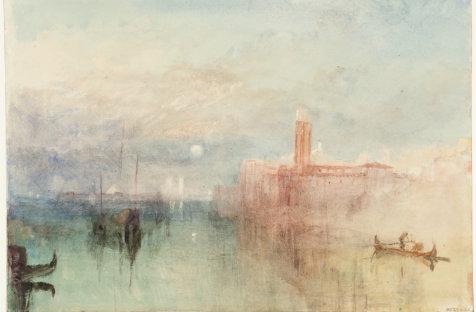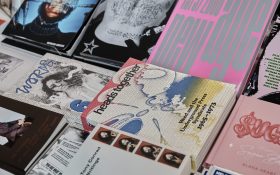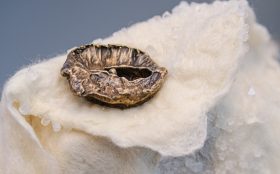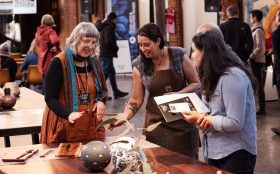JMW Turner is the subject of a major new exhibition at the Art Gallery of South Australia. Known as the painter of light, his famous evanescent, shimmering oils and watercolours have placed him at the forefront of English painting and exerted a considerable influence on the Impressionist movement.
In 1984 the Tate Gallery in London inaugurated an annual visual art prize in his name. This prize attracts mainstream publicity every year, mainly for its controversial winners and the infamous artworks that they submit. At first, it appears that Turner, a respectable master revered for landscapes and pictures of boats, is an unlikely artist to be honoured with an award for controversial, groundbreaking, contemporary art. Tracey Emin, for example, won with My Bed, a filthy unmade bed littered with a condom and cigarette butts, while Damien Hirst won with The Physical Impossibility of Death in the Mind of Someone Living, a shark-in-formaldehyde piece. This exhibition (subtitled ‘The Making of a Master’) shows that Turner himself was, like Emin and Hearst, a pioneering, visionary artist whose ground-breaking artworks generated fierce debate and attracted venomous criticism, proving that this tribute prize is aptly named.
The exhibition, co-curated by Ian Warrell of the Tate Gallery and Jane Messenger of the Art Gallery of South Australia, is the first major showcase of Turner’s work in Australia for over 20 years and includes many works never previously exhibited in this country. The exhibition, comprising over 100 works (more than 40 oil paintings and 60 watercolours) consists of works bequeathed by Turner to the British nation and several works owned by the Art Gallery of South Australia and other Australian galleries. Usually housed in a dedicated wing of Tate Britain in London, Turner’s paintings are displayed with elegance and skill in the Art Gallery of South Australia’s stunning exhibition space.
The exhibition is presented chronologically and tells the story of the barber’s son whose talent was cultivated through training, commissions, travel and experience to become a major player in the art world of early-mid 19th century Britain.
The first rooms show Turner developing his craft as an artist. On show are works that the 11-year-old Turner exhibited in the window of his father’s London barber shop. A gouache and graphite watercolour from this period, A Fishing Boat in a Rough Sea, Seen from Behind (1796-7), is an early demonstration of Turner’s affinity for seascapes. In the first decades of the 19th century Turner was commissioned to paint the estates of the wealthy. These commissions subsidised his ability to travel and paint seascapes and mountain landscapes inspired by the craggy hills of Wales and Scotland. It is during this period that human figures all but disappeared from his work.
The restrictions on travel resulting from the Napoleonic Wars meant that Turner was in his 40, and an established painter, when he first visited Italy in 1819. His greatest discovery in his travels was the Italian sunshine. His subsequent paintings are bathed in this golden glow. By this time many of Turner’s painting had become almost abstract and his numerous critics criticised his work for being ‘needlessly indistinct’ and for being ‘mere freaks of chromomania’. These late paintings are almost devoid of solid objects and details; the focus is clearly on the effect of light on water, the light from heavenly skies and the luminance of fire. These characteristics are apparent in two magnificent paintings from his 1840 Royal Academy exhibition, Sun Setting over a Lake (1840), and Waves Breaking on a Lee Shore at Margate (Study for ‘Rockets and Blue Lights) (1840) among others. Turner’s rebuttal to his detractors was that ‘Atmosphere is my style’ and it was this style that has led to him being heralded as a master.
Display cabinets containing Turner’s personal effects are thoughtfully positioned throughout the exhibition. Turner’s paint-splattered Chelsea palette, used in the last years of his career, is displayed next to his metal travelling paint box. The paint box includes an array of oil paints stored in tied pig bladders as well as one of the then newly-invented metal paint tubes that are the precursor to those used today. Unsurprisingly this tube contains yellow paint, his favourite colour, and the colour he is most associated with. Turner’s sketchbooks from 1797 and 1805, among others, are displayed and positioned in proximity to the finished artworks, providing further insight into Turner’s methods in creating a masterpiece.
A lack of specific biographical information at the entrance to the exhibition forced this reviewer and several other patrons to guess the year of Turner’s birth instead of reading it from a wall label. An obvious typographical error on one of the wall labels detracted from what was otherwise a meticulously presented exhibition.
Rating: 4 ½ stars out of 5
Turner from the Tate: The Making of a Master
Curated by Ian Warrell and Jane Messenger
Exhibition organised by Tate in association with Art Exhibitions Australia, Art Gallery of South Australia and the National Gallery of Australia
Art Gallery of South Australia
8 February – 19 May
Adelaide Festival 2013
www.adelaidefestival.com.au
1 – 17 March
National Gallery of Australia, Canberra
1 June – 8 September





